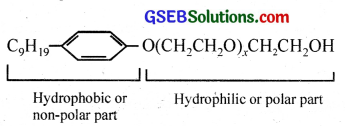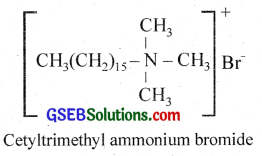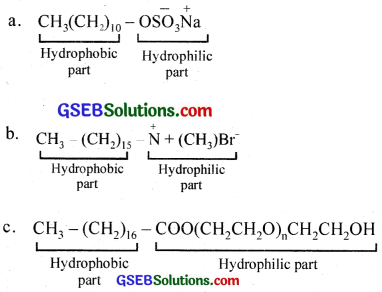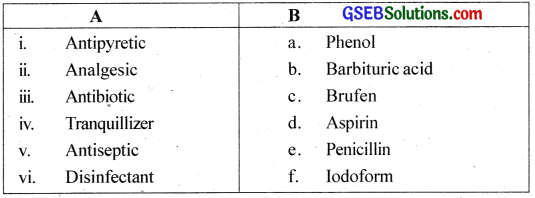Gujarat Board GSEB Textbook Solutions Class 12 Chemistry Chapter 16 Chemistry in Everyday Life Textbook Questions and Answers, Additional Important Questions, Notes Pdf.
Gujarat Board Textbook Solutions Class 12 Chemistry Chapter 16 Chemistry in Everyday Life
GSEB Class 12 Chemistry Chemistry in Everyday Life InText Questions and Answers
![]()
Question 1.
Sleeping pills are recommended by doctors to the patients suffering from sleeplessness. But it is not advisable to take its doses without consultation with the doctor. Why?
Answer:
Sleeping pills contain drugs that may be tranquilizers or anti-depressants. They affect the nervous system, relieve anxiety, stress, irritability, or excitement. But they should strictly be used under the supervision of a doctor. If not, the uncontrolled and overdose can cause harm to the body and mind because, in higher doses, these drugs act as poisons.
Question 2.
With reference to which classification has the statement, “ranitidine is an antacid” been given?
Answer:
Based on the pharmacological effect of the drug, ranitidine is an antacid. Ranitidine prevents the interaction of histamine with the receptors present in the stomach wall and reduces the release of acid in the stomach.
∴ It is an antacid.
![]()
Question 3.
Why do we require artificial sweetening agents?
Answer:
To reduce calorie intake and to protect teeth from decay, we need artificial sweeteners.
Question 4.
Write the chemical equation for preparing sodium soap from glyceryl oleate and glyceryl palmitate. Structural formulae of these compounds are given below.
(i) (C15H31COO)3C3H5 – Glyceryl palmitate
(ii) (C17H32COO)3C3H5 – Glyceryl oleate
Answer:

Question 5.
The following type of non-ionic detergents is present in liquid detergents, emulsifying agents and wetting agents. Label the hydrophilic and hydrophobic parts in the molecule. Identify the functional group(s) present in the molecule.

Answer:

GSEB Class 12 Chemistry Chemistry in Everyday Life Text Book Questions and Answers
Question 1.
Why do we need to classify drugs in different ways?
Answer:
Various schemes of classification of drugs and the utilities of such classification are as follows.
- Classification based on pharmacological effect is useful for doctors because it provides them the whole range of drugs available for the treatment of a particular ailment.
- Classification on the basis of drug action on a particular biochemical process is useful for choosing the correct lead compound for designing the synthesis of the desired drug.
- Classification on the basis of chemical structure helps us to synthesize structurally similar compounds having different substituents and then choosing the drug having the highest effectiveness.
- Classification on the basis of molecular targets is useful for medicinal chemists so that they can design a drug which is most effective for a particular receptor site.
![]()
Question 2.
Explain the term, target molecules or drug targets as used in medicinal chemistry.
Answer:
(i) Compounds which can interact with the target and hence are expected to the therapeutically active and are thus chosen as starting points for drug designing are called lead compounds.
(ii) Drugs interact with biological macromolecules like proteins, enzymes, carbohydrates, lipids and nucleic acid and hence are called drug target.
Question 3.
Name the macromolecules that are chosen as drug targets.
Answer:
Macromolecules like proteins, enzymes, nucleic acids, carbohydrates and lipids are chosen as drug targets.
Question 4.
Why should not medicines be taken without consulting doctors?
Answer:
Most of the drugs taken in higher doses than recommended may cause harmful effects and can act as poisons. Also, side effects arise when a drug binds to more than one receptor site. So, medicines should not be taken without consulting the doctors.
Question 5.
Define the term chemotherapy.
Answer:
The branch of chemistry’ which deals with the treatment of diseases using chemicals is called chemotherapy.
Question 6.
Which forces are involved in holding the drugs to the active site of enzymes?
Answer:
Hydrogen bonding, ionic bonding, dipole-dipole interactions and van der Waal’s interactions are involved in holding the drug to the active site of enzymes.
![]()
Question 7.
While antacids and antiallergic drugs interfere with the function of histamines, why do these not interfere with the function of each other?
Answer:
This is because antacids and antiallergic drugs work on different receptors. For example, histamine causes allergy and it also causes acidity due to release of HCl in stomach. The use of antihistamines removes allergy while antacids removes acidity because they work on different receptors.
Question 8.
Low level of noradrenaline is the cause of depression. What type of drugs are needed to cure this problem? Name two drugs.
Answer:
Noradrenaline is a neurotransmitter and its low level causes depression. This can be cured by using antidepressant drugs. They inhibit the enzymes which catalyse the degradation of noradrenaline thereby activating noradrenaline receptor for longer periods of time. This counteracts depression. Iproniazid and phenelzine are examples of antidepressants.
Question 9.
What is meant by the term ‘broad spectrum antibiotics’? Explain.
Answer:
Antibiotics which are effective against several different types of microorganisms are called broad spectrum antibiotics, example Tetracyclin, chloramphenicol etc. Chloramphenicol can be used to treat typhoid, dysentery, acute fever, urinary infections, meningitis and pneumonia.
![]()
Question 10.
How do antiseptics differ from disinfectants? Give one example of each.
Answer:
Antiseptics:
- They do not harm the living tissues, but prevent or kill only the harmful microorganisms.
- They are applied to wounds, ulcers, diseased skin etc.
- example: Iodine, boric acid etc
Disinfectants:
- They are toxic to living tissues, but destroy harmful microorganisms.
- They are employed to disinfect floor, toilets, drains, instruments etc.
- example: Phenol
Question 11.
Why are cimetidine and ranitidine better antacids than sodium hydrogen carbonate or magnesium or aluminium hydroxide?
Answer:
They prevent the interaction of histamine with the receptor cells in the stomach wall and thus release lesser amount of HCl. But the use of excess of NaHCO3, or Mg(OH)2 or Al(OH)3 makes the stomach alkaline and this triggers the release of even more HCl which may cause ulcers in the stomach.
Question 12.
Name a substance which can be used as an antiseptic as well as disinfectant.
Answer:
0.2% solution of phenol can act as antiseptic while 1% solution can act as a disinfectant.
Question 13.
What are the main constituents of dettol?
Answer:
Chloroxylenol and α – terpineol in a suitable solvent.
![]()
Question 14.
What is tincture of iodine? What is its use?
Answer:
2-3% solution of iodine in alcohol – water mixture which is used as an antiseptic is known as tincture of iodine.
Question 15.
What are food preservatives?
Answer:
Chemical substances which are used to prevent food spoilage due to microbial growth are called preservatives.
Example: Sodium benzoate.
Question 16.
Why is use of aspartame limited to cold foods and drinks?
Answer:
Aspartame decomposes at baking or cooking temperatures and hence can be used only in cold foods and drinks.
Question 17.
What are artificial sweetening agents? Give two examples.
Answer:
Chemical substances which are sweet in taste but have nearly zero caloric content are called artificial sweetners.
Example: Saccharin, aspartame.
Question 18.
Name the sweetening agent used in the preparation of sweets for a diabetic patient.
Answer:
Aspartame
Question 19.
What problem arises in using aiitame as artificial sweetener?
Answer:
Aiitame is 2000 times sweeter than cane sugar and hence it is difficult to control the sweetness of the food to which it is added.
Question 20.
How are synthetic detergents better than soaps?
Answer:
Cleansing action of detergents is not affected by the Ca2+ and Mg2+ ions present in hard water. But soaps do not work well in hard water.
![]()
Question 21.
Explain the following terms with suitable examples
(i) Cationic detergents
(ii) Anionic detergents
(iii) Non-ionic detergents.
Answer:
(i) Cationic surface active detergents are those which have cationic hydrophilic part. Cationic detergents are quaternary ammonium salts of amines with anions. Cationic part possesses a long hydrocarbon chain and a positive charge on nitrogen, example Cetyltrimethyl ammonium bromide. These are used for hair conditioners and are expensive.

Cationic detergents have germicidal properties.
(ii) Anionic surface active detergents are Those which contain anionic hydrophilic group. Sodium salts of alkyl benzenesulphonates are important class of anionic detergents.

They are mostly used for household work and are also used in toothpastes.
(iii) Neutral surface active detergents have non – ionic but polar groups that can from hydrogen bond with water. Polyethylene glycol reacts with stearic acid to form non-ionic detergents.

Liquid dish-washing detergents are of non-ionic type. Mechanism of cleansing action of this type of detergents is same as that of soaps. These are becoming increasingly popular because they are superior for cleaning synthetic fibres.
Detergents having straight hydrocarbon chains are easily degraded (or decomposed) by microorganisms and hence are called biodegradable detergents, example: Sodium lauryl sulphate, sodium 4-(1-dodecyl) benzene sulphonate, sodium 4-(2-dodecyl) benzene sulphonate.
Detergents containing branched hydrocarbon chains are not easily degraded by the microorganisms and hence are called non-biodegradable detergents, example: Sodium 4-(1,3,5,7- tetramethyloctyl) benzenesulphonate.
![]()
Question 22.
What are biodegradable and non-biodegradable detergents? Give one example of each.
Answer:
(i) Detergents having straight hydrocarbon chains are easily degraded (or decomposed) by microorganisms and hence are called biodegradable detergents.
Example : Sodium lauryl sulphate, sodium 4 – ( 1 – dodecyl) benzene sulphonate, sodium 4 – (2 – dodecyl) benzene sulphonate.
(ii) Detergents containing branched hydrocarbon chains is not easily degraded by the microorganisms and hence are called non – biodegradabie detergents.
Example : Sodium 4-(1, 3, 5, 7 – tetramethyloctyl) benzenesulphonate.
Question 23.
Why do soaps not work in hard water?
Answer:
Hard water contains Ca2+ and Mg2+ ions. Thus in hard water, soaps get precipitated as calcium and magnesium salts, which being insoluble stick to the cloths as gummy mass.
Question 24.
Can you use soaps and synthetic detergents to check the hardness of water?
Answer:
Soaps get precipitated as insoluble calcium and magnesium soaps in hard water but detergents do not. Therefore soaps can be used to check the hardness of water.
Question 25.
If water contains dissolved calcium hydrogen carbonate, out of soaps and synthetic detergents which one will you use for cleaning clothes?
Answer:
Water which contains calcium bicarbonate is hard. Since soap can form a precipitate with Ca2+, they are not fit for cleansing. While synthetic detergents do not precipitate in hard water. Therefore, synthetic detergents can be used for cleaning.
![]()
Question 26.
Label the hydrophilic and hydrophobic parts in the following compounds.
(a) CH3(CH3)10CH2OSO3–Na+
(b) CH3(CH2)15N+(CH3),Br–
(c) CH3(CH2)16COO(CH2CH2O)nCH2CH2OH
Answer:

GSEB Class 12 Chemistry Chemistry in Everyday Life Additional Important Questions and Answers
Question 1.
The discovery of antibiotics makes the treatment of diseases very easy.
(i) What do you understand by ‘antibiotics’?
(ii) Which was the first antibiotic and who discovered it?
(iii) How are the antibiotics classified?
(iv) Write a note on sulpha drugs.
Answer:
(i) Antibiotics are chemical substances produced by micro-organisms which can inhibit the growth or even destroy other micro-organisms.
(ii) The first antibiotic discovered was penicillin by Alexander Fleming in 1929 from a mould called penicillium notatum.
(iii) These are classified into narrow spectrum antibiotics and broad spectrum antibiotics.
- Narrow spectrum antibiotics – These are effective against only a few micro-organisms, example: penicillin.
- Broad spectrum antibiotics – These are substances which attack a wide range of micro-organisms, example: tetracyclin, chloramphenicol etc.
(iv) Sulpha drugs were the first effective chemotherapeutic agents widely used in curing the bacterial infections like pneumonia, tuberculosis and diphtheria.
The bacteria responsible for the disease absorb the sulpha drugs and thus stop the growth and further multiplication. These are usually derivatives of sulphanilamide. example sulphadiazine, sulphathiazole etc.
![]()
Question 2.
What are antihistamine? Give two examples
Answer:
Antihistamines are drugs which either reduce or inhabit the action of histamine in the body thereby preventing allergy Two important antihistamines are brompheniramine and terfenadine
Mode of action: Histamines interact with the binding sites of receptor in the body to produce allergy Antihistamines compete with histamines for these binding sites of receptor and thus do not allow histamine to produce allergy.
Question 3.
Match the following.

Answer:
i. d
ii. c
iii. e
iv. b
v. f
vi. a
![]()
Question 4.
What is the nature of an antacid?
Answer:
Substances which reduce the release of excess HCl by preventing the interaction of histamine with the receptors present in the stomach wall are called antacids Examples cimetidine and ranitidine.